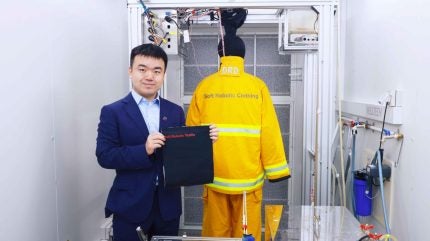
A team led by Dr Dahua Shou, Limin Endowed Young Scholar in Advanced Textiles Technologies and Associate Professor of the School of Fashion and Textiles of The Hong Kong Polytechnic University (PolyU) has developed a “first-of-its-kind” thermally-insulated and breathable soft robotic apparel that can automatically adapt to changing ambient temperatures, thereby helping to ensure worker safety in high heat environments.
Their research findings have been published in the international interdisciplinary journal Advanced Science.
Maintaining a constant body temperature is one of the most critical requirements for living and working. High-temperature environments elevate energy consumption, leading to increased heat stress, thus exacerbating chronic conditions such as cardiovascular disease, diabetes, mental health issues and asthma, while also increasing the risk of infectious disease transmission. According to the World Health Organisation, globally, there were approximately 489,000 heat-related deaths annually between 2000 and 2019, with 45% occurring in Asia and 36% in Europe.
Traditional gear has been limited by statically fixed thermal resistance, which can lead to overheating and discomfort in moderate conditions, while its heat insulation may not offer sufficient protection in extreme fire events and other high-temperature environments. To address this issue, Dr Shou and his team have developed intelligent soft robotic clothing for automatic temperature adaptation and thermal insulation in hot environments, offering superior personal protection and thermal comfort across a range of temperatures.
The protective clothing developed by the team uses soft robotic textile for dynamic adaptive thermal management. Soft actuators, designed like a human network-patterned exoskeleton and encapsulating a non-toxic, non-flammable, low-boiling-point fluid, were strategically embedded within the clothing. This thermo-stimulated system turns the fluid from a liquid into a gas when the ambient temperature rises, causing expansion of soft actuators and thickening the textile matrix, thereby enhancing the gap of still air and doubling the thermal resistance from 0.23 to 0.48 Km²/W. The protective clothing can also keep the inner surface temperatures at least 10°C cooler than conventional heat-resistant clothing, even when the outer surface reaches 120°C.
Dr Shou said: “Our soft robotic clothing can seamlessly adapt to different seasons and climates, multiple working and living conditions, and transitions between indoor and outdoor environments to help users experience constant thermal comfort under intense heat.”

US Tariffs are shifting - will you react or anticipate?
Don’t let policy changes catch you off guard. Stay proactive with real-time data and expert analysis.
By GlobalDataLooking forward, Dr Shou finds the innovation to have a wide range of potential applications, from activewear, winter jackets, healthcare apparel and outdoor gear, to sustainable textile-based insulation for construction and buildings, contributing to energy-saving efforts. Supported by the Innovation and Technology Commission and the Hong Kong Research Institute of Textiles and Apparel, Dr Shou and his team have also extended the thermo-adaptive concept to develop inflatable, breathable jackets and warm clothing. This soft robotic clothing is suitable for low-temperature environments or sudden temperature drops to aid those who are stranded in the wilderness to maintain normal body temperature.



